Making fine prints in your digital darkroom
Pixels, images, and files
by Norman Koren
|
|
 |
|
This pages introduces the fundamental concepts of digital images:
what
they are, how their size and resolution is specified, and how they are
stored.
| Related pages: | Making fine prints... Getting started | Photo printers | Scanners |
| A
digital image is a
rectangular
grid of pixels, or "picture
elements," illustrated by the image on the right, which consists of 52x35
pixels; 1820 total. It has been enlarged 5x
(to 260x175 pixels) to make the
pixels
visible. Pixels appear as squares when enlarged in this way.
Digital images exist as an array of bytes in a computer's RAM memory or as files in memory cards, hard drives, and CDs or DVDs. Several popular file formats are described below. |
Each pixel typically consists of 8 bits (1 byte) for a Black and White (B&W) image or 24 bits (3 bytes) for a color image-- one byte each for Red, Green, and Blue. 8 bits represents 28 = 256 tonal levels (0-255). 16-bit B&W and 48-bit color image formats are also available; each pixel represents 216 = 65,536 tonal levels. Editing images in 16/48-bits produces the highest quality results; you can save images in 8/24 bits after editing is complete. An image's resolution is the total number of pixels, e.g., 1600 x2000 = 3.2 Megapixels, which corresponds to 3.2 Megabytes inside your computer for 8-bit B&W images or 9.6 Megabytes for 24-bit (3 bytes/pixel) color images. There are several other definitions of "resolution." See the explanation below.
Digital images are obtained from digital cameras or by scanning film or prints. Scanners are specified by their dpi or ppi resolution-- dots (actually, pixels) per inch they can obtain from the source. Scanning the original source-- the negative or slide-- always produces better quality than scanning a print. Printers are specified by their dpi (dots per inch) "resolution," typically 720, 1440 or 2880 for Epson. This number is the stepper motor pitch, not the actual visual resolution. It typically requires several printer dots to represent one image pixel. You don't need to worry about the correspondence between image pixels and printer dots; this is handled by the image editor and printer driver software.
 |
Considerable confusion arises because image size is specified
by the
number of pixels, the "resolution" in dots or pixels per inch (dpi or
ppi),
and the physical size (width and height). But
the only attribute that counts is the number of pixels.
The image on the left was taken on the Canon EOS-10D, converted from RAW using the Canon File Viewer Utility (which I've since replaced with Capture One DSLR LE), adjusted for color (though far from finished), then resized to 260x175 pixels wide in my favorite image editor, Picture Window Pro. |
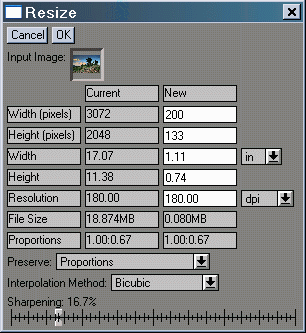 .
.
size = pixels/dpi (or pixels/ppi)It make no difference whether the image is 3437 dpi, 22.7x15.1 mm (the actual size of the EOS-10D digital sensor) or 17.07 dpi, 15x10 feet (a billboard); each of the 3072x2048 (6.3 million) pixels (6.3 megapixels) is exactly the same. I didn't change the Resolution (dpi setting) when I resized the image, hence the "size" of the new 200x133 pixel image size is tiny: 1.11x0.74 inches. This "size" is completely unrelated to the size you see on your monitor.
To add to the confusion, the word "Resolution" has several meanings. It can be the highest spatial frequency where a line pattern is visible: See the series on Image sharpness and MTF. It often refers to the total pixel count of an image, e.g., 3072x2048 pixels for the EOS-10D. I prefer either of these definitions to the dpi/ppi setting, which has nothing to do with the total detail present in an image, and which can be changed without changing a single pixel. But we're stuck with it in image editing programs.
You can easily change Resolution
(dpi), hence Width
and Height,
without
changing pixel count, i.e., you can rescale
the image without resizing
(i.e., resampling)
it. In Picture
Window Pro, open the Resize
dialog box (above), click on the arrow to the right of the Preserve,
then select File Size and Proportions.
When you can change either Width,
Height,
or Resolution (dpi), the other two
follow. In Photoshop, open the Image
Size dialog box, shown below, and leave Resample
Image unchecked. Check Resample
Image if you want to change the pixel
count--
to resize
the image.
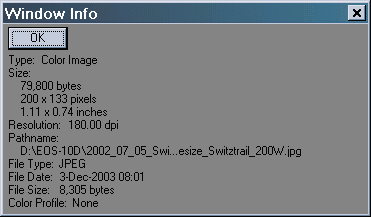 |
Picture Window Pro
If you right-click on the image in Picture Window Pro, then click on Display info, the Window Info box appears. The properties of the resized 200x133 pixel image are shown on the left. The Size numbers are the same as the New column in Resize dialog box, above. But the File Size, 8,305 pixels, is much smaller than the 79,800 byte image size (200x133 pixels x 3 bytes/pixel). This is the result of JPEG compression. GIF and PNG files are also compressed, but TIFF files are not: Image and file sizes are the same. I usually sharpen an image (using the simple Sharpen transformation,with Amount around 70%) after resizing it down. |
In Picture Window Pro you select the print size when you print. The
Width and Height attributes are ignored. This doesn't exactly hold for
Photoshop.
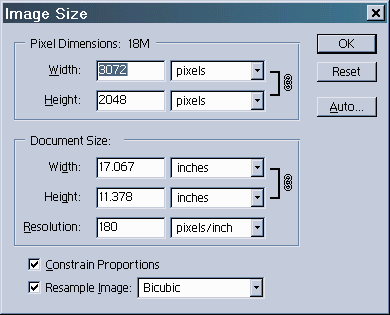
|
|
Perceived print quality* |
|
|
Outstanding. As sharp as most printers can print; about as sharp as the eye can see at normal viewing distances. |
|
|
Excellent.
Close
to 300 PPI for small prints, 8½x11 (or A4) and smaller.
Outstanding quality in large prints, 11x17" (or A3) and larger, which tend to be viewed from greater distances. |
|
|
OK for large prints. Adequate, but not optimum, for small prints. |
|
|
Adequate, but not optimum, for large prints. Mediocre for small prints. |
300 pixels per inch (ppi) is about as sharp as the eye can see on an
inkjet print; it can be very impressive in a print from a sharp
image file. Remember,
these numbers are actual
pixels per inch on the print, not the ppi setting of the image file.
When an image is sent to the printer, the image editor or printer driver resizes it to the printer's native resolution-- 720 dpi for Epson Photo printers; 600 dpi for HP and Canon. No manual resizing is required. There is some controversy about how good a job image editors do (particularly Photoshop). Read Qimage Print Quality Challenge to learn more. I'm pleased with the results I get from Picture Window Pro.
Most digital images must be resized down for the monitor display-- for web pages or e-mail. Many people are careful to scale the resized images to 72 dpi. Absolutely unnecessary. I know of no web browser or viewing software that pays any attention to the dpi setting. Most monitors actually display 80-100 pixels per inch, anyway.
| The image on the right is used as to illustrate compression.
It is
a 24-bit color 260x175 pixel image
(3 bytes per pixel), and therefore contains 136,500 bytes (136.5
kB). It was stored as a 100% Quality JPEG, 46.3
kB in size. The compression ratio is 136.5/46.3 = 2.95x.
100% JPEGs are virtually indistinguishable from uncompressed TIFF
images--
they contain a tiny loss that would only become visible after the file
was repeatedly opened and saved. The storage required for this image in
each format is shown below in (bold blue).
Web browsers support JPEG, GIF, and PNG formats, but not TIFF. |
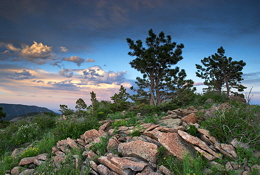 |
| The images below illustrate the effects of the JPEG Quality setting on image compression with Picture Window Pro. The dialog box is shown on the right. I use quality levels between about 80 and 95% for most images in this site. |  |
 |
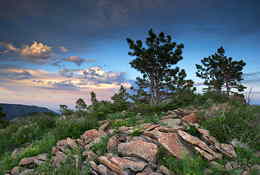 |
 |
| 90% quality; 15.3 kB; 8.9x.Quality is close to 100%, but a little waviness-- the classic JPEG artifact-- is visible in the sky near the trees. | 70% quality; 8.9 kB; 15.3x. Image quality is still pretty good, but wavy artifacts are significantly worse and detail in the rocks is reduced. | 30% quality; 6.1 kB; 22.4x. Image quality is quite poor. Wavy artifacts are obvious; there is significant loss of detail, and square zones are visible in the sky. |
Every program has its own JPEG Quality settings; there is no universal standard. Photoshop has settings between 0 and 12. IrfanView (a handy little editing utility) has settings between 0 and 100. The relationship between settings in different programs is anything but linear. PW Pro Quality = 70% (8.9 kB) is roughly equivalent to Irfanview Quality = 50% (7.9 kB) and Photoshop Quality = 3 (33 kB in Photoshop CS; 13.8 kB in Photoshop 6). Photoshop files are considerably larger, even though have no embedded ICC profiles, perhaps because they have extra space reserved for Exif data (digital camera settings). This can be a disadvantage for small images used for Web display.
Many digital cameras store images in JPEG format. This can lead to problems because image quality can deteriorate when images are saved and reloaded in JPEG format. The deterioration is tiny when files are saved at the highest possible JPEG quality, but it can become serious if less than maximum JPEG quality is selected. JPEGs should be used with caution for images intended for high quality quality printed output. If you plan to do much editing on a JPEG image, it's best to convert it to TIFF. No quality is lost when images are stored and reloaded in TIFF format.
Additional file formats You
may occasionally encounter these, but they're not recommended for
general
use.
Macintosh users should add
the appropriate three leter suffix (JPG, TIF, PNG, etc.) to file names
to make it easier for us Windows users to read.

| Images and text copyright (C) 2000-2013 by Norman Koren. Norman Koren lives in Boulder, Colorado, where he worked in developing magnetic recording technology for high capacity data storage systems until 2001. Since 2003 most of his time has been devoted to the development of Imatest. He has been involved with photography since 1964. |  |